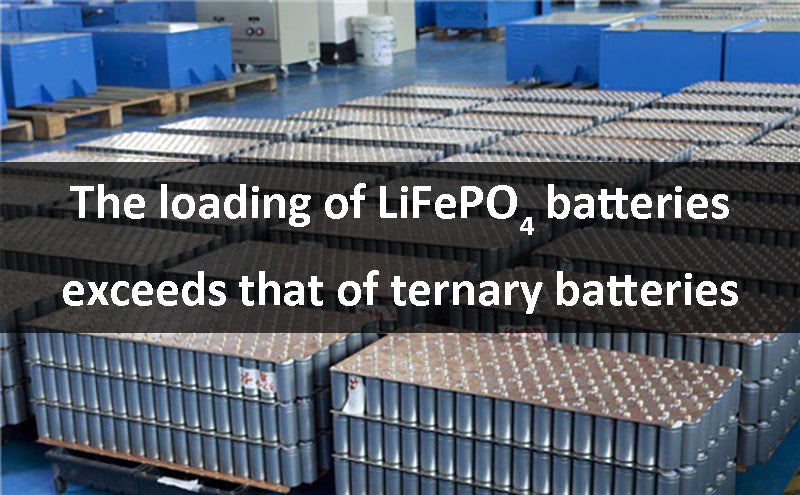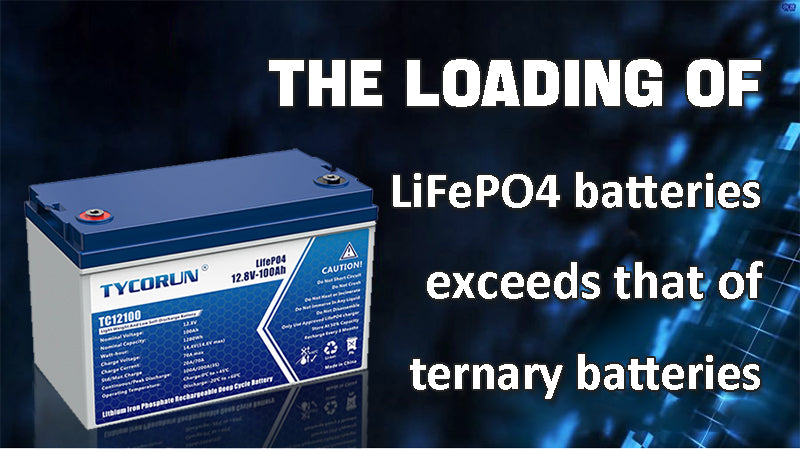
Main content:
With the hot sale of new energy vehicles, lithium iron phosphate batteries belonging to different technical routes of core components are outperforming ternary batteries. The latest data shows that lithium iron phosphate batteries accounted for nearly 60% of the vehicle loading in July, showing a high-speed positive growth compared with ternary batteries. At the same time, the export of lithium iron phosphate batteries is also increasing. Relevant reporters learned through interviews with a number of listed companies in the industry chain that with the advantages of performance and safety, lithium iron phosphate batteries are outperforming ternary batteries.
1. The loading of LiFePO4 batteries exceeds that of ternary batteries
According to statistics, the installed capacity of power batteries in China reached 24.2GWh in July, a year-on-year increase of 114.2% and a month-on-month decrease of 10.5%. It is worth noting that the proportion of lithium iron phosphate batteries in July compared with ternary batteries has increased. The installed capacity of ternary batteries was 9.8GWh, accounting for 40.7% of the total installed capacity, a year-on-year increase of 80.4% and a month-on-month decrease of 15%. The installed capacity of lithium iron phosphate batteries was 14.3GWh, accounting for 59.3% of the total installed capacity, a year-on-year increase of 147.2% and a month-on-month decrease of 7%.
In terms of output, ternary batteries also show disadvantages compared with lithium iron phosphate batteries. In July, the output of lithium iron phosphate batteries showed a high-speed positive growth year-on-year and month-on-month, reaching 228% and 33.5% respectively (194% and 19.2% in June). The output of ternary batteries not only dropped to 107.7% year-on-year, but also directly changed to -9.4% month-on-month.

In terms of new energy and new models, lithium iron phosphate batteries are taking a significant lead. Relevant announcements show that there are as many as 34 new models equipped with lithium iron phosphate batteries, and 17 new models of ternary batteries are the second largest, and lithium iron phosphate batteries are stronger than other types of batteries. In terms of exports, among the total export volume of power batteries in July, the export volume of lithium iron phosphate batteries was as high as 1.5GWh, accounting for 73.6% of the total export volume, occupying a major position.
2. Lithium iron phosphate battery has achieved staged advantages
As the core components of new energy vehicles, lithium iron phosphate batteries and ternary batteries were previously in a long-term competitive relationship. Due to factors such as China's new energy vehicle subsidies tilting towards high energy density at that time, the period from 2016 to 2019 was a stage of rapid increase in the proportion of ternary batteries, and in 2019, it accounted for the majority of the installed capacity of power batteries.
Regarding the recent overtake of lithium iron phosphate batteries, experts who have followed and studied the battery technology route have analyzed that there are many kinds of cathode materials for lithium ion batteries, including lithium cobalt oxide, lithium manganate, lithium nickel oxide, ternary materials, lithium iron phosphate, etc. Relatively speaking, the ternary battery has higher energy density and good cycle performance, but its high-temperature structure is unstable, which leads to poor high-temperature safety, and is prone to cell flatulence, which leads to explosion, especially during the puncture experiment. In addition, the cost of ternary batteries containing more precious metals is also higher than that of lithium iron phosphate batteries.
Experts said that for consumers, the choice of ternary or lithium iron phosphate battery should be determined according to their own conditions. If charging is convenient, it is actually more suitable to choose a lithium iron phosphate electric vehicle that is cheaper and has a shorter cruising range. However, if charging is troublesome, you can choose a ternary battery electric vehicle with a longer range to reduce mileage anxiety. Industry experts pointed out that in the past two years, with the increasing requirements of car companies to reduce costs and improve safety and stability of electric vehicles, lithium iron phosphate battery manufacturers have increased their research and development efforts, launched a number of new products, and achieved breakthroughs in performance.

However, relatively speaking, the pace of technical iteration of ternary batteries is much slower, and there is a lack of new products. Lithium iron phosphate batteries have achieved staged advantages in performance. BYD, one company of top 10 power battery companies has previously launched a blade battery. As a new generation of lithium iron phosphate battery, the blade battery not only has a volume energy density close to that of a ternary battery, but also has a high volume density that allows high capacity batteries to be arranged in a smaller space to achieve longer cruising range. With the support of the new lithium iron phosphate battery, BYD's new energy vehicles have been recognized by more consumers, and their sales have continued to rise.
According to the latest data, BYD, which focuses on blade batteries, sold 158,957 new energy vehicles in July, which is already on a par with traditional international car companies such as Honda and Volkswagen. Not only BYD, GAC Group has also released a new battery product - microcrystalline SmLFP. By introducing the second phase in the lithium iron phosphate battery anode microcrystalline, innovative technologies such as improved lithium iron phosphate battery energy density, low temperature, fast charge, cycle performance, such as the quality of traditional lithium iron phosphate battery monomer can be up 13% energy density and the volume energy density increase 20%, also improved the poor low temperature performance of lithium iron phosphate batteries.
3. Power batteries usher in a new pattern
Changes in the competitive landscape of lithium iron phosphate batteries and ternary batteries have begun to affect the performance of related listed companies. Relevant data shows that CATL, a leading company in the power battery market, installed 11.41GWh of vehicles in July, continuing to lead the market with a market share of 47.19%. Followed by BYD's FinDreams battery, the installed capacity is 6.10GWh, and the market share has reached 25.23%. Although CATL still maintains the No. 1 position in terms of total installed capacity, with the continued popularity of lithium iron phosphate batteries, BYD has overtaken this market segment.

From the specific data, in July BYD's lithium iron phosphate battery loading volume was 6.01GWh, with a market share of 41.90%. CATL is 5.36GWh, with a market share of 37.37%. BYD's lithium iron phosphate battery is expected to continue to expand. On August 15, the Chinese government announced that BYD planned to invest 28.5 billion RMB in Jiangxi Province to build a power battery project with an annual output of 30GWh and a comprehensive development and utilization production base project with an annual output of 100,000 tons of battery-grade lithium carbonate and ceramic soil (containing lithium) ore mining.
In addition, the person in charge of BYD also previously introduced that Tesla's Shanghai Gigafactory will also use BYD's lithium iron phosphate batteries. Industry professionals told reporters that the future to ternary battery in Tesla 4860 battery mass production as a sign, ternary battery will usher in a new round of energy density improvement, while the cost is also expected to decline, the market balance may be again inclined to ternary battery.
Related article: top 10 4680 battery companies, 4680 battery vs 18650, top 10 lithium iron phosphate materials companies















